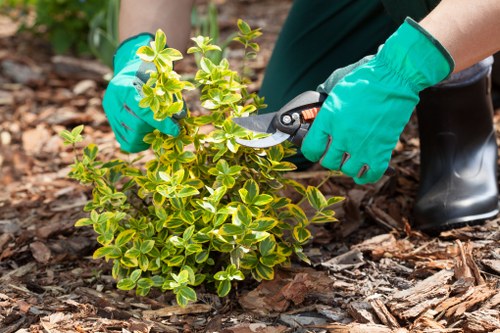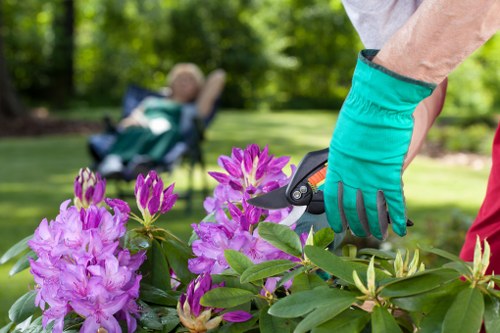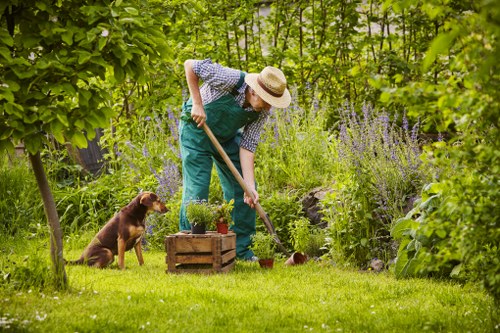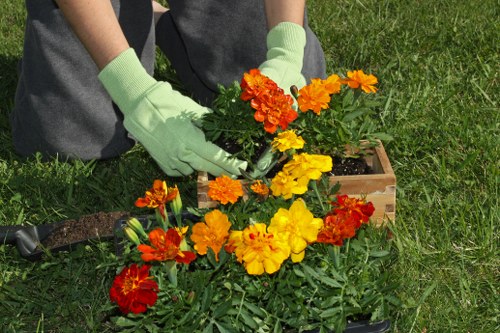Mastering Hedge Trimming in Beckenham: Your Comprehensive Guide
Introduction to Hedge Trimming

Maintaining a well-trimmed hedge is essential for both the aesthetics and health of your garden. In Beckenham, where gardens are a significant part of the community's charm, hedge trimming plays a crucial role in enhancing curb appeal and providing privacy. Proper hedge trimming not only keeps your plants looking neat but also promotes vigorous growth, preventing diseases and pests.
Hedge trimming involves more than just cutting back overgrown branches. It requires understanding the specific needs of different hedge types, the right tools, and the best techniques to ensure that your hedges thrive year-round. Whether you’re a seasoned gardener or a homeowner looking to improve your garden's appearance, mastering the art of hedge trimming in Beckenham can make a significant difference.
In this article, we will delve into the various aspects of hedge trimming, including the best times to trim, the tools you need, and expert tips to achieve professional results. By the end of this guide, you'll be equipped with the knowledge to keep your hedges in top shape, enhancing the overall beauty of your Beckenham home.
Understanding Different Types of Hedges

Beckenham gardens boast a variety of hedge types, each requiring specific trimming techniques. Understanding the characteristics of your hedge will help you determine the best approach to maintain its health and appearance.
Evergreen Hedges
Evergreen hedges, such as boxwood and privet, retain their leaves throughout the year, providing constant greenery and privacy. These hedges require regular trimming to maintain their shape and density. Due to their dense foliage, evergreen hedges are excellent for creating privacy screens and windbreaks.
Deciduous Hedges
Deciduous hedges, like hawthorn and yew, lose their leaves in the autumn, allowing light to pass through during the winter months. Trimming deciduous hedges is essential to prevent them from becoming too dense and to encourage new growth in the spring. These hedges add seasonal interest to your garden with their changing foliage colors.
Flowering Hedges
Flowering hedges, such as forsythia and lilac, bloom during specific seasons, adding vibrant colors and delightful fragrances to your garden. Proper trimming of flowering hedges ensures that they produce abundant blooms and maintain a pleasing shape. Timing is crucial to avoid cutting off next year's flowers.
By recognizing the type of hedge you have, you can tailor your trimming practices to suit its unique needs, ensuring a healthy and attractive garden all year round.
Regular maintenance and appropriate trimming schedules will prolong the life of your hedges and keep them looking their best. Whether you prefer a formal, neatly shaped hedge or a more natural, relaxed appearance, understanding hedge types is the first step towards achieving your desired garden aesthetic.
When is the Best Time to Trim Hedges?

Timing is critical when it comes to hedge trimming. Trimming at the right time ensures that your hedges remain healthy, promote new growth, and avoid potential damage. In Beckenham's climate, understanding the seasonal cycles is key to determining the optimal times for hedge trimming.
Spring Trimming
Early spring, before new growth begins, is an ideal time to trim most hedges. Trimming at this stage encourages dense and vigorous growth, setting the stage for a lush, green hedge throughout the summer. Be cautious with flowering hedges, as improper timing can reduce blooming.
Summer Trimming
Light trimming in midsummer helps maintain the shape of your hedges and prevent them from becoming overgrown. It’s an excellent time for shaping and reducing the size of fast-growing varieties. However, avoid heavy trimming during the peak of summer heat to prevent stress on the plants.
Autumn Trimming
Late autumn trimming is suitable for hedges that need a light touch-up before winter. This period allows the hedges to recover during the dormant season. However, avoid trimming too late in the season, as new growth stimulated by winter weather can be damaged by frost.
Winter Trimming
Winter is generally not recommended for hedge trimming, as most hedges are dormant and susceptible to frost damage. Only minimal trimming should be done if necessary, focusing on removing any dead or damaged branches to prepare the hedge for the coming growing season.
By adhering to the proper trimming schedule, you ensure the longevity and beauty of your hedges. Consult with local gardening experts in Beckenham to tailor the timing to your specific hedge varieties and local climate conditions.
Proper timing not only enhances the appearance of your hedges but also contributes to their overall health, making it a fundamental aspect of successful hedge trimming in Beckenham.
Essential Tools for Hedge Trimming

Having the right tools is essential for effective hedge trimming. The appropriate equipment not only makes the task easier but also ensures a clean and precise cut, promoting the health of your hedges.
Pruning Shears
Pruning shears are ideal for small hedges and detailed shaping work. They provide the precision needed for fine cuts and intricate designs, making them a vital tool for any gardener.
Hedge Trimmers
Hedge trimmers come in various types, including manual, electric, and gas-powered. They are perfect for larger hedges, allowing you to trim quickly and efficiently. Electric trimmers are suitable for smaller gardens, while gas-powered models are better for extensive trimming tasks.
Secateurs and Loppers
For thicker branches that cannot be handled by pruning shears, secateurs and loppers are essential. These tools provide the necessary leverage to cut through tougher stems without damaging the plant.
Protective Gear
Safety should never be overlooked. Wearing protective gloves, goggles, and long sleeves protects you from potential injuries and debris. Additionally, using ear protection when operating loud trimmers can prevent hearing damage.
- Pruning Shears for precision cuts
- Electric or Gas-Powered Hedge Trimmers for efficiency
- Secateurs and Loppers for thicker branches
- Protective Gear: Gloves, Goggles, Ear Protection
Investing in high-quality tools will not only make hedge trimming more manageable but also deliver superior results, keeping your hedges healthy and beautifully shaped.
Regular maintenance of your tools, such as sharpening blades and ensuring batteries are charged, will extend their lifespan and performance, making your hedge trimming sessions more effective.
Step-by-Step Guide to Hedge Trimming

Achieving a neatly trimmed hedge involves several steps, from preparation to the final touches. Following a systematic approach ensures that your hedges are both aesthetically pleasing and healthy.
1. Assess the Hedge
Begin by evaluating the overall condition and shape of your hedge. Identify any diseased branches, overgrown areas, and the desired shape you wish to achieve. This assessment will guide your trimming strategy.
2. Gather Your Tools
Ensure you have all the necessary tools within reach. Clean and sharpen your pruning shears, hedge trimmers, and any other equipment to ensure smooth and accurate cuts.
3. Trim the Sides
Start by trimming the sides of the hedge. Use hedge trimmers for an even and uniform appearance. Maintain a consistent shape by using a string or a guide as a reference.
4. Trim the Top
Once the sides are done, focus on the top. Trim lightly to create a flat or slightly rounded top, depending on your preference. Avoid cutting too much, as this can stress the plant.
5. Remove Dead or Diseased Branches
Inspect the hedge for any dead or diseased branches and remove them carefully. This prevents the spread of diseases and encourages healthy new growth.
6. Clean Up
After trimming, collect and dispose of the clippings to keep your garden tidy. This also helps prevent pests and diseases from lingering.
- Assess the overall condition and shape
- Gather and prepare your tools
- Trim the sides for uniformity
- Lightly trim the top
- Remove any dead or diseased branches
- Clean up the garden area
By following these steps, you can achieve a professional-looking hedge trim that enhances the beauty of your garden and ensures the health of your hedges for years to come.
Consistency is key in hedge trimming. Regular trims prevent your hedges from becoming unruly and make maintenance easier over time. Schedule your trimming sessions according to your hedge's growth rate and seasonal requirements.
Common Mistakes to Avoid

Even with the best intentions, certain mistakes can hinder the effectiveness of your hedge trimming efforts. Being aware of these common pitfalls can help you maintain healthy and well-shaped hedges.
Over-Trimming
One of the most frequent errors is cutting back too much. Over-trimming can stress the plant, making it susceptible to diseases and pests. It's essential to trim gradually, ensuring you never remove more than a third of the hedge's foliage at one time.
Incorrect Timing
Trimming at the wrong time of year can disrupt the hedge's growth cycle. For instance, trimming flowering hedges too late in the season can reduce their blooming potential. Always adhere to the recommended trimming schedule for your specific hedge type.
Using Dull Tools
Dull blades can tear the plant tissues instead of making clean cuts, leading to a higher risk of infections. Regularly sharpen your tools to ensure precise and clean trimming.
Neglecting Safety Precautions
Failing to wear appropriate protective gear can result in injuries from flying debris or accidental cuts. Always prioritize safety by using gloves, goggles, and other necessary protective equipment.
- Don't remove more than a third of the hedge
- Avoid trimming during the wrong season
- Ensure tools are sharp and clean
- Always wear protective gear
By avoiding these common mistakes, you can ensure that your hedge trimming efforts lead to healthy and attractive hedges rather than causing unintended damage.
Regularly reviewing your trimming techniques and staying informed about best practices can help you continually improve your hedge maintenance routine.
Remember, less is often more when it comes to hedge trimming. Taking a cautious and informed approach will yield the best results for your garden.
Hiring Professional Hedge Trimming Services in Beckenham

While DIY hedge trimming can be rewarding, there are instances where hiring a professional service in Beckenham is the best option. Professional gardeners bring expertise, specialized tools, and efficiency to the task, ensuring optimal results.
Benefits of Professional Services
- Expert knowledge of different hedge types and trimming techniques
- Access to advanced equipment for precise trimming
- Time-saving, allowing you to focus on other aspects of garden maintenance
- Ensures safety, reducing the risk of accidents during trimming
Choosing the Right Service
When selecting a professional hedge trimming service in Beckenham, consider the following factors:
- Experience and expertise in hedge trimming
- Positive customer reviews and testimonials
- Transparent pricing and value for money
- Insurance and guarantees for the work performed
- Availability and flexibility to suit your schedule
Questions to Ask Potential Providers
Before committing to a service, ask questions to ensure they meet your expectations:
- What is your experience with hedge trimming in Beckenham?
- Do you use environmentally friendly practices?
- Can you provide references or examples of previous work?
- What is your pricing structure?
Hiring a reputable professional ensures that your hedges are maintained to the highest standards, enhancing the beauty and value of your property.
Investing in professional hedge trimming services can lead to healthier, more attractive hedges that require less maintenance over time, providing long-term benefits for your garden.
Maintaining Your Hedges Between Trims

Regular maintenance between trimming sessions is essential to keep your hedges healthy and looking their best. Consistent care prevents overgrowth and ensures that your hedges remain in optimal condition.
Watering and Fertilizing
Proper watering and fertilizing are crucial for the health of your hedges. Ensure that your hedges receive adequate water, especially during dry spells. Fertilizing in the spring and autumn promotes strong growth and vibrant foliage.
Weed Control
Weeds can compete with your hedges for nutrients and water. Regularly remove weeds from around the base of your hedges to prevent competition and maintain soil health.
Pest and Disease Management
Monitor your hedges for signs of pests and diseases. Early detection and treatment are vital to prevent widespread issues. Use eco-friendly pest control methods to maintain a healthy garden environment.
Shaping and Light Trimming
In between major trimming sessions, perform light shaping and trimming to keep your hedges in shape. This helps maintain a tidy appearance and prevents the need for more extensive trimming later.
- Regular watering and fertilizing
- Consistent weed control
- Monitor and manage pests and diseases
- Perform light shaping as needed
By adhering to a regular maintenance schedule, you can ensure that your hedges remain healthy, vibrant, and well-shaped, reducing the effort required during major trimming sessions.
Maintaining your hedges between trims also fosters a stronger and more resilient plant, capable of withstanding environmental stresses and reducing the likelihood of damage.
Eco-Friendly Hedge Trimming Practices

Embracing eco-friendly practices in hedge trimming contributes to a sustainable garden and a healthier environment. Implementing green techniques ensures that your hedges thrive without harming the ecosystem.
Using Sustainable Tools
Opt for tools that are energy-efficient and have a minimal environmental impact. Electric hedge trimmers are preferable to gas-powered ones as they produce fewer emissions. Additionally, maintaining your tools prolongs their lifespan and reduces waste.
Organic Fertilizers and Pest Control
Choose organic fertilizers and natural pest control methods to nourish your hedges and manage pests without the use of harmful chemicals. Compost and well-rotted manure provide essential nutrients, while introducing beneficial insects can help control pest populations naturally.
Recycling Clippings
Instead of discarding hedge trimmings, consider composting them. Compost provides valuable nutrients to your garden and reduces landfill waste. Mulching with trimmings can also help retain soil moisture and suppress weeds.
Water Conservation
Implement water-saving techniques such as drip irrigation and mulching to reduce water usage while ensuring your hedges receive adequate hydration. Collecting rainwater for garden use is another effective conservation strategy.
- Use energy-efficient and sustainable tools
- Apply organic fertilizers and natural pest control
- Compost or mulch hedge clippings
- Adopt water-saving irrigation methods
By integrating eco-friendly practices into your hedge trimming routine, you not only maintain beautiful hedges but also contribute to the broader goal of environmental sustainability.
Eco-friendly hedge trimming enhances the overall health of your garden, creating a harmonious balance between aesthetics and nature.
Conclusion: Achieving Beautiful Hedges in Beckenham

Hedge trimming in Beckenham is a rewarding endeavor that enhances the beauty and functionality of your garden. By understanding the types of hedges, the best trimming times, essential tools, and effective techniques, you can maintain stunning hedges that complement your home.
Whether you choose to undertake the task yourself or hire professional services, prioritizing the health and appearance of your hedges ensures a vibrant and inviting garden space. Implementing regular maintenance and eco-friendly practices further contributes to the sustainability and longevity of your hedges.
Embrace the art of hedge trimming and transform your Beckenham garden into a lush, well-maintained sanctuary that reflects your personal style and care.
Contact us today to schedule your hedge trimming service and take the first step towards a more beautiful and healthy garden!
